The Consumer Price Index had no change for January as energy prices declined once again. Gasoline alone plunged by -4.8% for the month. Inflation without food or energy prices considered increased 0.3% with shelter and medical costs leading the charge. From a year ago overall CPI has increased 1.4%, which is double the annual rate of last month. Without energy and food considered, prices have increased 2.2% for the year. CPI measures inflation, or price increases.
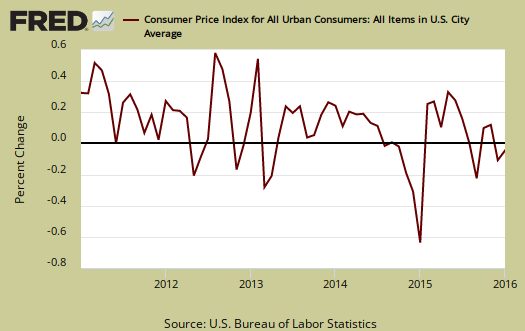
Yearly overall inflation is shown in the below graph.
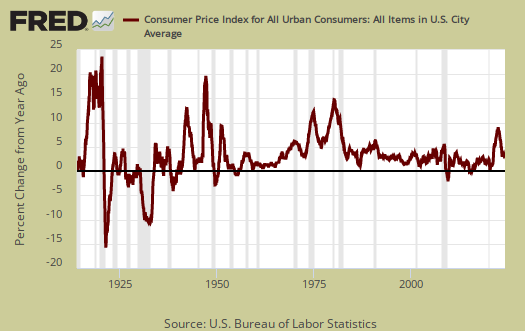
Core inflation, or CPI with all food and energy items removed from the index, has increased 2.2% for the last year. This is the highest annual core inflation increase since July 2012. For the past decade the annualized inflation rate has been 1.9%.
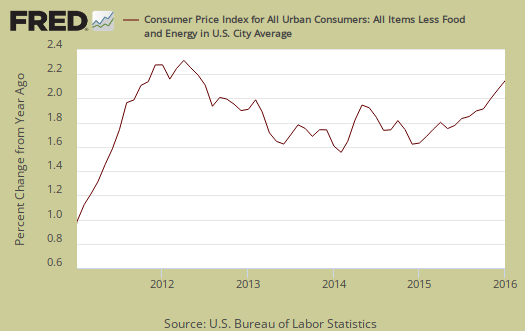
Core CPI's monthly percentage change is graphed below. This month core inflation increased 0.3%. Within core inflation, shelter increased 0.3%, with monthly rental costs increasing more than home ownership, 0.3% vs. 0.2%. Apparel prices increased 0.6%, used cars increased 0.1%, new vehicles 0.3% and and airfare increased 1.2% for the month. Auto insurance increased again, this time 0.4% for the month.

The energy index is down 6.5% from a year ago. The BLS separates out all energy costs and puts them together into one index. For the year, gasoline has declined -7.3%, while Fuel oil has dropped -28.7%. Fuel oil dropped -6.5% for the month alone. Graphed below is the overall CPI energy index.
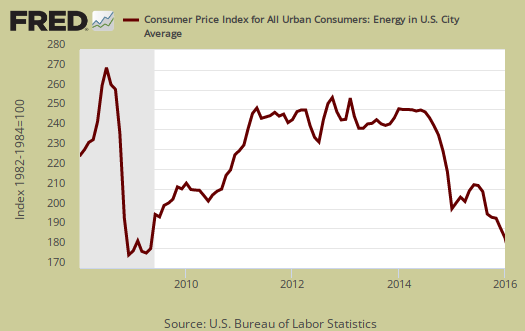
Graphed below is the CPI gasoline index only as gas-guzzlers continue their merry 4 by 4 dance.

Core inflation's components include shelter, transportation, medical care and anything that is not food or energy. The shelter index is comprised of rent, the equivalent cost of owning a home, hotels and motels. Shelter increased 0.3% and is up 3.2% for the year. Rent of a primary residence just keeps increasing and this month by 0.3% and is up 3.7% for the year. Graphed below is the rent price index.
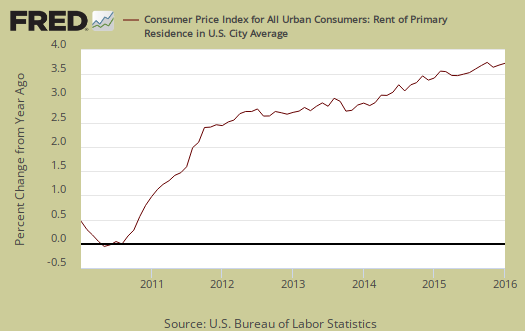
Food prices had no change for the month. Food and beverages have now increased just 0.8% from a year ago. Groceries, (called food atnbs home by BLS), dropped -0.2% for the month, and are down -0.5% for the year. The meats, poultry, fish, and eggs index declined by -1.3%. The eggs index had it's largest monthly drop since October 2010, -8.4%. About time as eggs have increased dramatically in the past year due to the culling of flocks with the Avian flu. Eating out, or food away from home increased 0.3% for the month and is up 2.7% for the year.
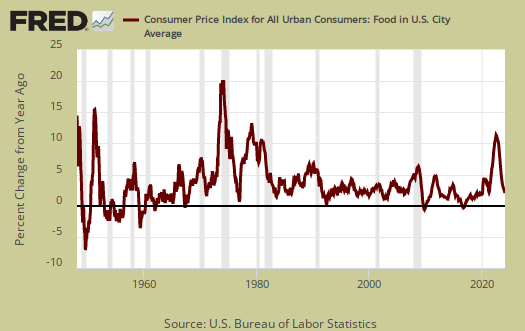
Graphed below are grocery price increases, otherwise known as the food at home index.
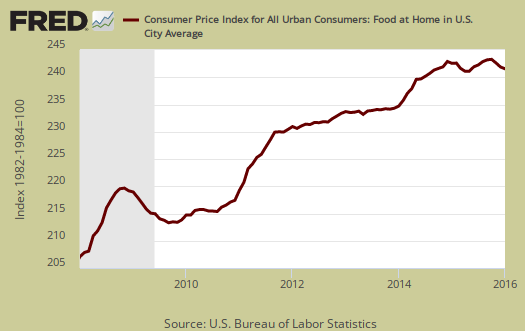
Medical care is part of core inflation. But the rate of increases is so outrageous, they need their own special attention. Medical care services were up 0.15% for the month and have increased 3.3% for the year. Graphed below is the overall medical care index, which increased 0.3% for the month and is up 3.0% from a year ago.

Below is a graph of the medical commodities index, which is mostly prescription drug prices. Medical commodities increased 0.5% for the month and is up 3.3% for the past year.
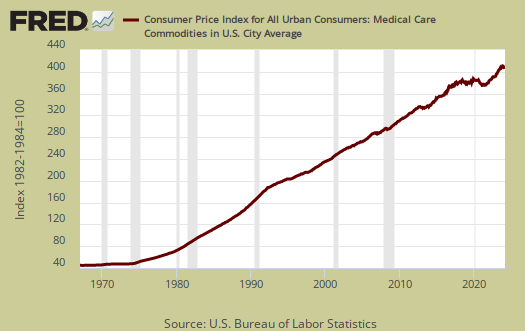
Real hourly earnings increased by 0.4% for all employees. Real means wages adjusted for inflation and since CPI had no change and wages increased by a solid 0.5%. For the year real hourly earnings have increased 1.1%, clearly not staying ahead of the rent and shelter game. The average real hourly wage is now $10.66. Weekly real earnings increased 0.7% for the month. Real weekly earnings now stand at $368.95. Average weekly hours increased 0.3% to 34.6/wk. There is a separate category for production and nonsupervisory employees and their real hourly earnings increased 0.3%.
CPI details
The DOL/BLS does take yearly surveys on where the money goes in the monthly budget, but as one can see, food and energy are significant amounts of the monthly finances. Run away costs in these two areas can break the bank, so can food. Additionally CPI uses substitution, so if flour goes through the roof, somehow we're all just fine with oats and prices didn't really overall increase much. Here is the BLS CPI site, where one can find much more details, information on calculation methods and error margins.
Other CPI report overviews, unrevised, although most graphs are updated, are here. If you're wondering why the graphs display different figures from the text, the graphs calculate percentages from the index and do not round. The actual data from the BLS report does round to one decimal place. In other words, 0.05% is rounded to 0.1%.

decent start to 1st quarter PCE
with the release of the CPI, we should be able to estimate the economic impact of last week's January retail sales report...for the most accurate estimate, and the way the BEA will be figuring 1st quarter GDP at the end of April, we would have to take each type of retail sales and adjust it with the appropriate change in price to determine real sales; for instance, January's clothing store sales, which rose by 0.2% in dollars, should be adjusted with the price index for apparel, which was up by 0.6%, to show us that real retail sales of clothing were actually down 0.4% in January...then, to get a GDP relevant quarterly change, we'd have to compare those January real clothing sales with real clothing consumption for the months of October, November and December, and then repeat that process for each other type of retailer, obviously quite a tedious task to undertake manually...the short cut we usually use for a ballpark estimate is to apply the composite price index of all commodities less food and energy commodities, which was up 0.2%, to retail sales less grocery, gas station, and restaurant sales, which accounts for nearly 70% of the aggregate sales....those sales were up almost 0.4% in January, and since their price index was up 0.2%, real retail sales excluding food and energy sales were up approximately 0.2%...then, for the rest of the total, we find sales at grocery stores were up 0.8%, while prices for food at home were down 0.2%, suggesting a real increase of 1.0% in the volume of food purchased in January....next, sales at bars and restaurants were down 0.5% in dollars, and in addition those dollars bought 0.3% less, so real sales of food away from home were actually down about 0.8%...and while gas station sales were down 3.3%, gasoline prices were down 4.8%, suggesting a solid real increase in gasoline sold, with the caveat that gas stations sell more than gasoline, and we don't have the details on that...weighing the food and energy components at one third of total retail sales suggests that net real retail sales were up on the order of 0.2% in January, following a real decrease of 0.3% in December, an increase of 1.0% in November, and a decrease of 0.1% in October (data which we get from Table 7 of the income and outlays report (pdf))...that means we can estimate that January's real consumption of goods was 0.2% higher than that of December, 0.1% lower than that of November, and 0.9% higher than that of October, suggesting a real increase of more than 0.3% in January from the average monthly real sales of the 4th quarter..
rjs